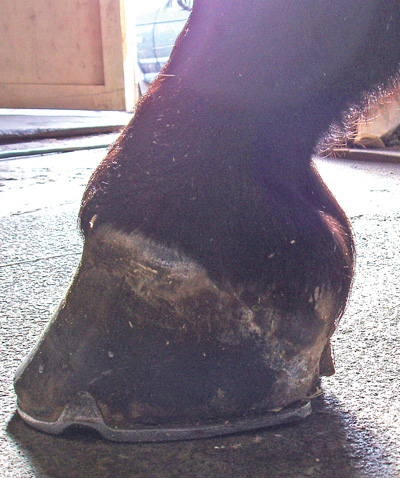For more than 4 years, New York farrier Taylor Keenan has worked with an Oldenburg that has a severe club foot. Not only would you not call this a “text book case,” but you might as well threw the text book away with this horse.
Over a few years, several different modalities have been employed to keep this horse going. For example in April 2012, he applied a toe plate that had tremendous results. The feedback from the rider and the trainer is the horse has never moved better.
“How simple is it to glue an aluminum toe plate to a club foot? I find this modality compared to screwing a steel shoe to a Dalric cuff or nailing or gluing a toe plate to a third of the foot is really pretty simple. However, it’s not one that you would read about because you can create the same negative palmer angle by trimming the heels appropriately for that particular case. Why aren’t you increasing leverage on the toe?
“Those were the challenges I was getting. Most people I talked to said it did not make sense. Welcome to the real world! It doesn’t always have to make sense. If the horse is comfortable, don’t try to make it look like a picture in a book.
“This is the interesting aspect of this case, which I have never had in any other case I have done. I’ve never been this mentally challenged by any other case. I’ve never read books or research about how you get a horse this size jumping 2-foot, 6-inch jumps on a club foot this severe.”

A club foot presents challenges to a farrier and the other members of a team.
Keenan measures the heel length each time so he can trim it to that length every time and knows what size shoe to use. He also examines the photos he shoots of the foot.
“I know how I trim the foot based on the photos — that’s a reason why I take photos because nearly every time I see something new,” he says.
Getting to this point wasn’t easy, and Keenan credits the patience of all involved. But, that doesn’t mean there weren’t frustrations along the way.
“Roller coasters have to go up before they come back down, and then back up again. Although the horse was really shining at one point, it was only a few weeks later that we would be down again.”
“This horse and this case have taught me so much,” Keenan says. “The challenges are never-ending. It creates an opportunity to think outside the box and talk about it with colleagues. And it begs to ask the question ‘What do we really know about clubbed feet?’ How do you shoe it based on the recovery of a tenotomy that went wrong?”
You can read more about this case study in the Sept./Oct. 2012 issue of American Farriers Journal.






